User:Dohn joe/Aero-airplane
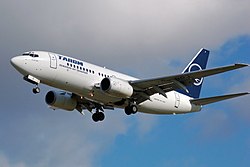
| Part of a series on Categories of aircraft | ||||||||||||||||||
|---|---|---|---|---|---|---|---|---|---|---|---|---|---|---|---|---|---|---|
| Supported by lighter-than-air gases (aerostats) | ||||||||||||||||||
|
||||||||||||||||||
| Supported by LTA gases + aerodynamic lift | ||||||||||||||||||
|
||||||||||||||||||
| Supported by aerodynamic lift (aerodynes) | ||||||||||||||||||
|
||||||||||||||||||
| Other means of lift | ||||||||||||||||||
|
||||||||||||||||||
An aeroplane (also known as an airplane or simply plane) is a powered fixed-wing aircraft capable of flight using wings that generate lift due to the vehicle's forward airspeed and the shape of the wings. Planes are propelled forward by thrust, usually from a jet engine or propeller.
Most planes are flown by a pilot on board the aircraft, but some are designed to be remotely or computer-controlled.
Etymology
[edit]First attested in English in late 19th century, the word aeroplane derives from the French aéroplane, which comes from the Greek ἀήρ (aēr), "air"[1] + either Latin planus, "level",[2] or Greek πλάνος (planos), "wandering".[3][4] "Aeroplane" originally referred just to the wing, as it is a plane moving through the air.[5] In an example of synecdoche, the word for the wing came to refer to the entire aircraft.
Usage
[edit]In the United Kingdom and most of the Commonwealth, the term "aeroplane" is used. In the United States and Canada, the term "airplane" is used. The form "aeroplane" is the older of the two, dating back to the mid- to late-19th century.[6] The spelling "airplane" was first recorded in 1907.[7]
History
[edit]Antecendents
[edit]Many stories from antiquity involve flight, such as the Greek legend of Icarus and Daedalus, and the Vimana in ancient Indian epics. Around 400 BC in Greece, Archytas was reputed to have designed and built the first artificial, self-propelled flying device, a bird-shaped model propelled by a jet of what was probably steam, said to have flown some 200 m (660 ft).[8][9] This machine may have been suspended for its flight.[10][11]
Some of the earliest recorded attempts with gliders were those by the 9th-century poet Abbas Ibn Firnas and the 11th-century monk Eilmer of Malmesbury; both experiments injured their pilots.[12] Leonardo da Vinci researched the wing design of birds and designed a man-powered aircraft in his Codex on the Flight of Birds (1502).
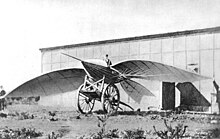
In 1799, Sir George Cayley set forth the concept of the modern aeroplane as a fixed-wing flying machine with separate systems for lift, propulsion, and control.[13][14] Cayley was building and flying models of fixed-wing aircraft as early as 1803, and he built a successful passenger-carrying glider in 1853.[15] In 1856, Frenchman Jean-Marie Le Bris made the first powered flight, by having his glider "L'Albatros artificiel" pulled by a horse on a beach.[citation needed] In 1883, the American John J. Montgomery made a controlled flight in a glider.[citation needed] Other aviators who made similar flights at that time were Otto Lilienthal, Percy Pilcher, and Octave Chanute.
Sir Hiram Maxim built a craft that weighed 3.5 tons, with a 110-foot (34-meter) wingspan that was powered by two 360-horsepower (270-kW) steam engines driving two propellers. In 1894, his machine was tested with overhead rails to prevent it from rising. The test showed that it had enough lift to take off. The craft was uncontrollable, which Maxim, it is presumed, realized, because he subsequently abandoned work on it.[16]
In the 1890s, Lawrence Hargrave conducted research on wing structures and developed a box kite that lifted the weight of a man. His box kite designs were widely adopted and became the prevalent type of aircraft until 1909.[verification needed] Although he also developed a type of rotary aircraft engine, he did not create and fly a powered fixed-wing aircraft.[17]
Between 1867 and 1896 the German pioneer of human aviation Otto Lilienthal developed heavier-than-air flight. He was the first person to make well-documented, repeated, successful gliding flights.

Early powered flights
[edit]The Wright brothers flights in 1903 are recognised by the Fédération Aéronautique Internationale (FAI), the standard setting and record-keeping body for aeronautics, as "the first sustained and controlled heavier-than-air powered flight".[18] By 1905, the Wright Flyer III was capable of fully controllable, stable flight for substantial periods. The Wright brothers credited Otto Lilienthal as a major inspiration for their decision to pursue manned flight.
In 1906, Alberto Santos Dumont made what has been claimed as the first airplane flight unassisted by catapult[19] and set the first world record recognised by the Aéro-Club de France by flying 220 metres (720 ft) in less than 22 seconds.[20] This flight was also certified by the FAI.[21][22]
An early aircraft design that brought together the modern monoplane tractor configuration was the Bleriot VIII design of 1908. It had movable tail surfaces controlling both yaw and pitch, a form of roll control supplied either by wing warping or by ailerons and controlled by its pilot with a joystick and rudder bar. It was an important predecessor of his later Bleriot XI Channel-crossing aircraft of the summer of 1909.[23]
World War I served as a testbed for the use of the aircraft as a weapon. Initially seen by the generals as a "toy", aircraft demonstrated their potential as mobile observation platforms, then proved themselves to be machines of war capable of causing casualties to the enemy. The earliest known aerial victory with a synchronised machine gun-armed fighter aircraft occurred in 1915, by German Luftstreitkräfte Leutnant Kurt Wintgens. Fighter aces appeared; the greatest (by number of air victories) was Manfred von Richthofen.
Following WWI, aircraft technology continued to develop. Alcock and Brown crossed the Atlantic non-stop for the first time in 1919. The first commercial flights took place between the United States and Canada in 1919.
Aircraft had a presence in all the major battles of World War II. They were an essential component of the military strategies of the period, such as the German Blitzkrieg or the American and Japanese aircraft carrier campaigns of the Pacific.
Development of jet aircraft
[edit]The first jet aircraft was the German Heinkel He 178, which was tested in 1939. In 1943, the Messerschmitt Me 262, the first jet fighter aircraft, went into service in the German Luftwaffe. In October 1947, the Bell X-1 was the first aircraft to exceed the speed of sound.[citation needed]
The first jet airliner, the de Havilland Comet, was introduced in 1952. The Boeing 707, the first widely successful commercial jet, was in commercial service for more than 50 years, from 1958 to 2010. The Boeing 747 was the world's biggest passenger aircraft from 1970 until it was surpassed by the Airbus A380 in 2005.
Overview
[edit]
Structure
[edit]The most common configuration of a plane includes:
- A fuselage, a long, thin body, often cylindrical, and usually with tapered or rounded ends to make its shape aerodynamically smooth. The fuselage may contain the flight crew, passengers, cargo or payload, fuel and engines the aircraft is designed for or they may be attached to it. The pilots of manned aircraft operate them from a cockpit located at the front or top of the fuselage and equipped with controls and usually windows and instruments. A plane may have more than one fuselage, or it may be fitted with booms with the tail located between the booms to allow the extreme rear of the fuselage to be useful for a variety of purposes.

- A large horizontal wing with an airfoil cross-section shape. The wing deflects air downward as the plane moves forward, generating lifting force to support it in flight. The wing also stabilises the plane's roll (tilt left or right), and the wing-mounted ailerons control rotation about the roll axis. A wide variety of wing configurations (e.g., multiplane aircraft and delta wing planform) have been used.

- A vertical stabiliser a vertical surface mounted at the rear of the plane and typically protruding above it. The vertical stabilizer stabilises the plane's yaw (turn left or right) and mounts the rudder which controls its rotation along that axis.
- A horizontal stabiliser or elevator, or tailplane, mounted at the tail of the plane, near the vertical stabilizer. The horizontal stabilizer is used to stabilise the plane's pitch (tilt up or down) and mounts the elevators which provide pitch control. A fixed portion of the elevators may be omitted in which case it is termed an all flying tail. Some planes use a front-mounted canard instead of a rear-mounted horizontal stabilizer.
- One or more engines that provide thrust to push the plane forward through the air. The most common propulsion units are propellers (powered by reciprocating or turbine engines) and jet engines (which provide thrust directly from the engine and usually also from a large fan mounted within the engine).

The Blohm & Voss BV 141 is unusual in being asymmetrical and as a result was not successful. - Landing gear, a set of wheels, skids, or floats that support the plane while it is on the surface. On seaplanes the bottom of the fuselage or floats (pontoons) support it while on the water. On some planes the landing gear retract during flight to reduce drag.
There are many different configurations of planes. A plane may have two or more fuselages, or additional pods or booms. Some planes have more than one horizontal or vertical stabilizer, while V-tail planes combine the horizontal and vertical stabilizers into a pair of diagonal surfaces. While all of the above items are essential - there have been planes flown that have dispensed with any one of the components listed, by modifying other components to fulfill the missing components function. A flying wing plane has no discernible fuselage structure and horizontal or vertical stabilizers, though it may have small blisters or pods. The opposite of this is a lifting body which has no wings, though it may have small stabilising and control surfaces. Delta wing planes often dispense with the horizontal stabilizer and a few planes have even dispensed with the vertical stabilizer.
Most planes are largely symmetrical along a plane of symmetry, excepting the propeller and minor alterations to counteract the effects of the spinning propeller.
Controls
[edit]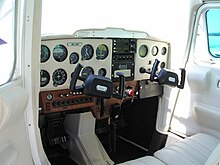
A number of controls allow pilots to direct planes in the air. The controls found in a typical plane are as follows:
- A yoke or joystick, which controls rotation of the plane about the pitch and roll axes. A yoke resembles a steering wheel, and a control stick is a joystick. The pilot can pitch the plane down by pushing on the yoke or stick, and pitch the plane up by pulling on it. Rolling the plane is accomplished by turning the yoke in the direction of the desired roll, or by tilting the control stick in that direction. Pitch changes are used to adjust the altitude and speed of the plane; roll changes assist the plane in turning in conjunction with the rudder. Control sticks and yokes are usually positioned between the pilot's legs; however, a sidestick is a type of control stick that is positioned on either side of the pilot.

Jet trainer cockpit showing stick and instruments 
Modern glass cockpit - the screens display the same information as dials would have - Rudder pedals, which control rotation of the plane about the yaw axis. There are two pedals that pivot so that when one is pressed forward the other moves backward, and vice versa. The pilot presses on the right rudder pedal to make the plane yaw to the right, and on the left pedal to make it yaw to the left. The rudder is used mainly to balance the plane in turns, or to compensate for winds or other effects that tend to turn the plane about the yaw axis. Several planes including the Ercoupe dispensed with rudder pedals by linking the rudders to the ailerons for simplicity.
- A Throttle or thrust lever for each engine. These control the power produced by the engines and hence airspeed. On piston-engine powered planes Engine Mixture Control levers will also be present.
- Brakes, used to slow and stop the plane on the ground, and sometimes for turns on the ground.
These were largely standardized during World War I - prior to which many plane manufacturers had their own systems.
Other controls can include:
- Flap levers, which are used to control the position of flaps on the wings.
- Spoiler levers, which are used to control the position of spoilers on the wings, and to arm their automatic deployment in planes designed to deploy them upon landing. The spoilers reduce lift for landing.
- Trim controls, which usually take the form of knobs or wheels and are used to adjust pitch, roll, or yaw trim. These are often connected to small airfoils on the trail edge of the control surfaces called 'trim tabs'. Trim is used to reduce the amount of pressure on the control forces needed to maintain a steady course.
- A tiller, a small wheel or lever used to steer the plane on the ground in conjunction with or instead of the rudder pedals (primarily found on larger aircraft).
- Undercarriage retraction levers, to raise or lower the undercarriage, for reduced drag while in flight.
- A parking brake, used to prevent the plane from rolling when it is parked on the ground.
The controls may allow full or partial automation of flight, such as an autopilot, a wing leveler, or a flight management system. Pilots adjust these controls to select a specific attitude or mode of flight, and then the associated automation maintains that attitude or mode until the pilot disables the automation or changes the settings. In general, the larger and/or more complex the plane, the greater the amount of automation available to pilots.
On a plane with a pilot and copilot, or instructor and trainee, the plane is made capable of control without the crew changing seats. The most common arrangement is two complete sets of controls, one for each of two pilots sitting side by side, but in some planes (military fighter aircraft, some taildraggers and aerobatic aircraft) the dual sets of controls are arranged one in front of the other (in tandem). A few of the less important controls may not be present in both positions, and one position is usually intended for the pilot in command (e.g., the left "captain's seat" in jet airliners). Some small planes use controls that can be moved from one position to another, such as a single yoke that can be swung into position in front of either the left-seat pilot or the right-seat pilot (e.g., Beechcraft Bonanza).
Planes that require more than one pilot usually have controls and displays intended to suit each pilot position, but still with sufficient duplication so that any of the pilots can fly the plane alone in an emergency. For example, in jet airliners, the controls on the left (captain's) side include both the basic controls and those normally manipulated by the pilot in command, such as the tiller, whereas those of the right (first officer's) side include the basic controls again and those normally manipulated by the copilot, such as flap levers. The unduplicated controls that are required for flight are positioned so that they can be reached by either pilot, but they are often designed to be more convenient to the pilot who manipulates them under normal conditions.
An unmanned aircraft is controlled remotely or via means such as gyroscopes or other forms of autonomous control.
Instruments
[edit]Instruments provide information to the pilot and the co-pilot. Flight instruments provide information about the plane's speed, direction, altitude, and orientation. Powerplant instruments provide information about the status of the plane's engines and APU. Systems instruments provide information about the plane's other systems, such as fuel delivery, electrical, and pressurisation. Navigation and communication instruments include all the plane's radios. Instruments may operate mechanically or electrically, requiring 12VDC, 24VDC, or 400 Hz power systems.[24] A plane that uses computerised CRT or LCD displays almost exclusively is said to have a glass cockpit.

The six basic instruments (sometimes referred to as the six pack) include:[25]
- An airspeed indicator, which indicates the speed at which the plane is moving through the surrounding air.
- An altimeter, which indicates the altitude or height of the plane above mean sea level.
- A heading indicator, (sometimes referred to as a "directional gyro (DG)"), which indicates the magnetic compass heading that the plane's fuselage is pointing towards. The actual direction the plane is flying towards is affected by the wind conditions.
- An attitude indicator, sometimes called an artificial horizon, which indicates the exact orientation of the plane about its pitch and roll axes.
- A vertical speed indicator, which shows the rate at which the plane is climbing or descending.
- A turn coordinator, or turn and bank indicator which helps the pilot maintain the plane in a coordinated attitude while turning.
Other instruments might include:
- A 2-way radio to enable communications with other planes and air traffic control. Planes built before World War II may not have been equipped with a radio but they are nearly essential now.
- A horizontal situation indicator, shows the position and movement of the plane as seen from above with respect to the ground, including course/heading and other information.
- Instruments showing the status of each engine in the plane (operating speed, thrust, temperature, rpms, and other variables).
- Combined display systems such as primary flight displays or navigation displays.
- Information displays such as on-board weather radar displays.
- A radio direction finder which indicates the direction to one or more radio beacons and which can be used to determine the plane's position.
- A satellite navigation system to provide an accurate position.
Design and construction
[edit]This section needs additional citations for verification. (May 2009) |
Most planes are constructed by companies with the objective of producing them in quantity for customers. The design and planning process, including safety tests, can last up to four years for small turboprops, and up to 12 years for planes with the capacity of the A380.
During this process, the objectives and design specifications of the plane are established. First the construction company uses drawings and equations, simulations, wind tunnel tests and experience to predict the behavior of the plane. Computers are used by companies to draw, plan and do initial simulations of the plane. Small models and mockups of all or certain parts of the plane are then tested in wind tunnels to verify its aerodynamics.
When the design has passed through these processes, the company constructs a limited number of these planes for testing on the ground. Representatives from an aviation governing agency often make a first flight. The flight tests continue until the plane has fulfilled all the requirements. Then, the governing public agency of aviation of the country authorises the company to begin production of the plane.
In the United States, this agency is the Federal Aviation Administration (FAA), and in the European Union, Joint Aviation Authorities (JAA). In Canada, the public agency in charge and authorising the mass production of planes is Transport Canada.
In the case of the international sales of planes, a license from the public agency of aviation or transports of the country where the plane is also to be used is necessary. For example, planes from Airbus need to be certified by the FAA to be flown in the United States and vice versa, planes of Boeing need to be approved by the JAA to be flown in the European Union.
Quieter planes are becoming more and more needed due to the increase in air traffic, particularly over urban areas, as aircraft noise pollution is a major concern.
Small planes can be designed and constructed by amateurs as homebuilts. Other homebuilt aircraft can be assembled using pre-manufactured kits of parts that can be assembled into a basic plane and must then be completed by the builder.
There are few companies that produce planes on a large scale. However, the production of a plane for one company is a process that actually involves dozens, or even hundreds, of other companies and plants, that produce the parts that go into the plane. For example, one company can be responsible for the production of the landing gear, while another one is responsible for the radar. The production of such parts is not limited to the same city or country; in the case of large plane manufacturing companies, such parts can come from all over the world.
The parts are sent to the main plant of the plane company, where the production line is located. In the case of large planes, production lines dedicated to the assembly of certain parts of the plane can exist, especially the wings and the fuselage.
When complete, a plane is rigorously inspected to search for imperfections and defects. After approval by inspectors, the plane is put through a series of flight tests to assure that all systems are working correctly and that the plane handles properly. Upon passing these tests, the plane is ready to receive the "final touchups" (internal configuration, painting, etc.), and is then ready for the customer.
Structural configuration
[edit]Number of wings
[edit]Monoplanes
[edit]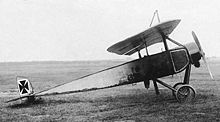
A monoplane has one main set of wing surfaces, which contrasts with a biplane or triplane. Since the late 1930s the monoplane has been the most common form of plane. The earliest monoplanes were braced with wires running outside the wing; however, lack of knowledge concerning the stresses a wing was subject to resulted in many failures, and in the United Kingdom the Royal Flying Corps banned their use.

The airfoil sections in use at the time were very thin, and could not have a cantilever structure installed within and so attempts were made to provide a stronger structure by adding an external truss - structurally a biplane, but lacking the lower wing. This configuration adds a lot of drag. Junkers began experimenting with thicker airfoils, which had previously been ignored as being unlikely to be efficient. With the thicker airfoils, a cantilever structure contained entirely within the wing was possible, and it had the added bonus that thick airfoils were more efficient than the thin ones previously in use. The defeat of Germany (where all of the research into cantilever monoplanes was occurring) and conservatism in the aviation industry ensured that biplanes would continue to dominate for the next 20 years.
Monoplanes can be differentiated in where the wings attach to the fuselage: The actual point of attachment is called the wing root.
- low-wing, the wing lower surface is level with (or below) the bottom of the fuselage
- mid-wing, the wing is mounted mid-way up the fuselage
- shoulder wing, the wing is mounted above the fuselage middle
- high-wing, the wing upper surface is level with or above the top of the fuselage
- parasol-wing, the wing is located above the fuselage with structural support being typically provided by a system of struts, and, especially in the case of older aircraft, wire bracing. These were particularly popular in the late 1920s and 1930s.

- gull wing is similar to a parasol wing, but has the roots of the wing drop down to pass the structure through the fuselage reducing the number of struts needed. A variant of the gull wing is the inverted gull wing, in which the lower wing takes the form of a "W" from the front, with the middle peak attached to the fuselage. This has the advantages of shortening the undercarriage, and simplifying the wing root design and was most famously used on the Vought F4U Corsair of World War II.
Biplanes
[edit]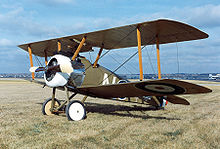
A biplane has two main wings, with one directly above the other. The Wright brothers' Wright Flyer used a biplane design, as did most aircraft in the early years of aviation. The primary reason many early planes were biplanes was that the two-wing configuration had a structural advantage over monoplanes, since both wings formed a Pratt truss, which was immensely strong. Due to the struts and the extra lifting surface, however, biplanes produce more drag and thus tend to be slower. Some later biplanes replaced the Pratt truss with a Warren truss which reduced the drag associated with the struts, however it wasn't enough to keep it competitive with cantilever monoplanes which superseded it for most purposes in the late 1930s. Its compact span for a given lifting area allows for great maneuverability and it is still used for aerobatics aircraft and crop dusting.
A sesquiplane is a specific type of biplane, where the (usually) lower wing is significantly smaller than the upper wing.
Triplanes and multiplanes
[edit]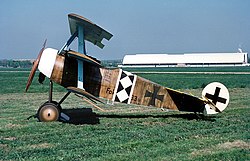
A triplane is equipped with three vertically-stacked wing planes. Tailplanes and canard foreplanes are not included in this count unless they overlap with other wings, nor usually are airfoil fairing on axles. Only a very small number of triplanes were ever built, but the format does have the advantage of allowing an aircraft a high degree of maneuverability combined with a very good climb rate. Due to the drag, however, as with biplanes, this type is obsolete and almost never used except in recreations, such as the Fokker Dr.I and Sopwith Triplane.
A multiplane has more than three wings, but is a rarely used format, as all of the disadvantages of the triplane are even more pronounced.
Wing geometry
[edit]Straight wing
[edit]A straight wing is a wing planform in which the centre of lift across the wing forms a straight line from wingtip to wingtip, or nearly so. This was the dominant form of wing until early transsonic aircraft adopted swept wings to reduce transsonic drag. Modern fighters were able to readopt straight wings thanks to advances in both aircraft structures and aerodynamic high lift devices.
Swept wing
[edit]A swept wing is a wing planform is which the wings are angled backwards so that the tips are closer to the tail than the roots, resembling an arrow. This was done to reduce the drag associated when approaching supersonic speeds and is the form primarily used on airliners and other jet transports. A variant of the swept wing is the forward swept wing in which the wings are angled forwards. This has serious structural implications and so hasn't been used very much, but has been tried because a regular swept wing has poor stall characteristics. When an aircraft's lift is less than what is required for it to continue flying and stalls, ideally the nose should drop, which allows the aircraft to regain flying speed. In a swept wing aircraft, the normal result of a stall is for the nose to go up, making recovery difficult.
Variable geometry
[edit]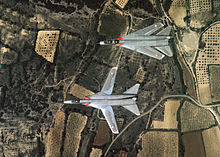
Variable geometry aircraft have wing configurations that can be changed in flight.
A variable-sweep wing is a wing that may be swept back and then returned to its original position during flight. While variable-sweep provides many advantages, particularly in takeoff distance, load-carrying ability, and the fast, low-level penetration role, the configuration imposes a considerable penalty in weight and complexity. The advent of relaxed stability flight control systems in the 1970s negated many of the disadvantages of a fixed platform. No new variable-sweep wing aircraft have been built since the Tu-160.
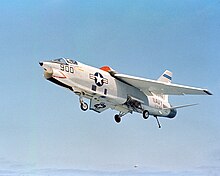
A variable camber wing changes the camber of the airfoil, and varies the area and camber of the wing. The various flaps and slats on the control surfaces of modern commercial airliners perform a similar function.
A variable-incidence wing has an adjustable angle of incidence (the angle between the wing and the fuselage) in order to reduce landing and take-off distances.
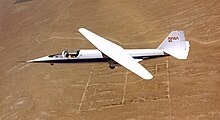
The necessary components add extra weight to the aircraft and increase maintenance costs. In some aircraft the benefits outweigh the costs, and variable-incidence functionality is incorporated into the design, most notably with the F-8 Crusader, although other designs have used it, such as the Martin XB-51. No modern aircraft has used this design since the F-8.
An oblique wing (also called a slew wing) is a variable geometry wing concept. On an aircraft so equipped, the wing is designed to rotate on center pivot, so that one tip is swept forward while the opposite tip is swept aft. By changing its sweep angle in this way, drag can be reduced at high speed (with the wing swept) without sacrificing low speed performance (with the wing perpendicular).
Delta wing
[edit]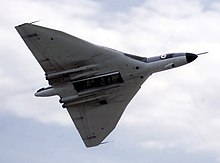
The delta wing is a wing planform in the form of a triangle. It is named for its similarity in shape to the Greek uppercase letter delta (Δ) and has many advantages over other configurations. The delta wing has more internal volume to carry fuel or internal weapons than a wing of a similar thickness to chord ratio, while also allowing wing loading to be reduced for the amount of drag produced in level flight. If its leading edge is raked back enough, it will escape the shock wave formed at the nose of the aircraft as transonic speeds are reached, reducing drag considerably, and the center of lift moves less than on conventionally configured aircraft, reducing trim drag.[26] As the angle of attack increases, the leading edge of the wing generates a vortex which smooths the airflow, giving the delta a very high stall angle at the cost of high induced drag which allows a larger range in speed than a conventional wing intended for high speed flight. Pure delta-wings fell out of favour somewhat due to poor gust response characteristics at low altitudes (they get bounced around a lot and so must fly slower and higher) and advances in high lift devices, however many of the advantages have been retained by use of leading edge root extensions, which act in the same manner and many modern fighter aircraft, such as the JAS 39 Gripen and the Eurofighter Typhoon use a delta wing, often in conjunction with a canard.
Airframe configuration
[edit]Canard
[edit]
Canard is an airframe configuration in which the forward surface is smaller than the rearward, the former being known as the "canard", while the latter is the main wing. In contrast, a conventional aircraft has a small horizontal stabilizer behind the main wing.[27][28][29]
Canard designs fall into two main classes: the lifting-canard and the control-canard.[30] With a lifting canard, the weight of the aircraft is shared between the main wing and the canard wing. In the control-canard, most of the weight of the aircraft is carried by the main wing and the canard wing is used primarily for longitudinal control during maneuvering. Thus, a control-canard mostly operates only as a control surface and is usually at zero angle of attack.
Tandem wing
[edit]
A tandem wing aircraft has two sets of wings, arranged one in front of the other rather than overlapping each other. NASA research has shown that they must be of different lifting characteristics otherwise a severe oscillation will develop, which has limited their use. A tandem wing can be distinguished from a canard by the location of the pitch controls (elevators) on the rear flying surface. A tandem wing may have the front wing larger than the rear, or the reverse. They have the advantage of normally using fewer struts than biplanes, but the induced drag of having multiple wings is still present, though interactions between the wings may reduce this over a conventional biplane.
Flying wing
[edit]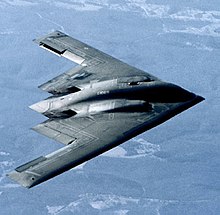
A flying wing is a tailless aircraft which has no definite fuselage, with most of the crew, payload and equipment being housed inside the main wing structure.[27]
The flying wing configuration was studied extensively in the 1930s and 1940s, notably by Jack Northrop and Cheston L. Eshelman in the United States, and Alexander Lippisch and the Horten brothers in Germany. After the war, a number of experimental designs were based on the flying wing concept, but the known difficulties remained intractable. Some general interest continued until the early 1950s but designs did not necessarily offer a great advantage in range and presented a number of technical problems, leading to the adoption of "conventional" solutions like the Convair B-36 and the B-52 Stratofortress. Due to the practical need for a deep wing, the flying wing concept is most practical for designs in the slow-to-medium speed range, and there has been continual interest in using it as a tactical airlifter design.
Interest in flying wings was renewed in the 1980s due to their potentially low radar reflection cross-sections. Stealth technology relies on shapes which only reflect radar waves in certain directions, thus making the aircraft hard to detect unless the radar receiver is at a specific position relative to the aircraft - a position that changes continuously as the aircraft moves. This approach eventually led to the Northrop B-2 Spirit stealth bomber. In this case the aerodynamic advantages of the flying wing are not the primary needs. However, modern computer-controlled fly-by-wire systems allowed for many of the aerodynamic drawbacks of the flying wing to be minimised, making for an efficient and stable long-range bomber.
Blended wing body
[edit]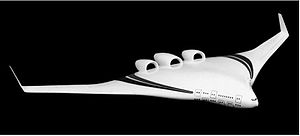
Blended wing body aircraft have a flattened and airfoil shaped body, which produces most of the lift to keep itself aloft, and distinct and separate wing structures, though the wings are smoothly blended in with the body.
Thus blended wing bodied aircraft incorporate design features from both a futuristic fuselage and flying wing design. The purported advantages of the blended wing body approach are efficient high-lift wings and a wide airfoil-shaped body. This enables the entire craft to contribute to lift generation with the result of potentially increased fuel economy.
Lifting body
[edit]
A lifting body is a configuration in which the body itself produces lift. In contrast to a flying wing, which is a wing with minimal or no conventional fuselage, a lifting body can be thought of as a fuselage with little or no conventional wing. Whereas a flying wing seeks to maximize cruise efficiency at subsonic speeds by eliminating non-lifting surfaces, lifting bodies generally minimize the drag and structure of a wing for subsonic, supersonic, and hypersonic flight, or, spacecraft re-entry. All of these flight regimes pose challenges for proper flight stability.
Lifting bodies were a major area of research in the 1960s and 70s as a means to build a small and lightweight manned spacecraft. The US built a number of famous lifting body rocket planes to test the concept, as well as several rocket-launched re-entry vehicles that were tested over the Pacific. Interest waned as the US Air Force lost interest in the manned mission, and major development ended during the Space Shuttle design process when it became clear that the highly shaped fuselages made it difficult to fit fuel tankage.
Propulsion
[edit]Propeller engines
[edit]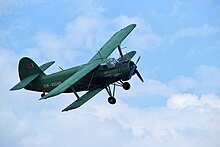
Smaller and older propeller planes make use of reciprocating engines (or piston engines) to turn a propeller to create thrust. The amount of thrust a propeller creates is determined by its disk area - the area in which the blades rotate. If the area is too small, efficiency is poor, and if the area is large, the propeller must rotate at a very low speed to avoid going supersonic and creating a lot of noise, and not much thrust. Because of this limitation, propellers are favoured for planes which travel at below mach .5, while jets are a better choice above that speed. Propeller engines may be quieter than jet engines (though not always) and may cost less to purchase maintain and so remain common on light general aviation aircraft such as the Cessna 172. Larger modern propeller planes such as the Dash 8 use a jet engine to turn the propeller, primarily because an equivalent piston engine in power output would be much larger and more complex.
Jet engines
[edit]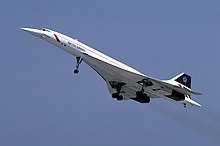
Jet aircraft are propelled by jet engines, which are used because the aerodynamic limitations of propellers do not apply to jet propulsion. These engines are much more powerful than a reciprocating engine for a given size or weight and are comparatively quiet and work well at higher altitude. Most modern jet planes use turbofan jet engines which balance the advantages of a propeller, while retaining the exhaust speed and power of a jet. This is essentially a ducted propeller attached to a jet engine, much like a turboprop, but with a smaller diameter. When installed on an airliner, it is efficient so long as it remains below the speed of sound (or subsonic). Jet fighters and other supersonic aircraft that do not spend a great deal of time supersonic also often use turbofans, but to function, air intake ducting is needed to slow the air down so that when it arrives at the front of the turbofan, it is subsonic. When passing through the engine, it is then re-accelerated back to supersonic speeds. To further boost the power output, fuel is dumped into the exhaust stream, where it ignites. This is called an afterburner and has been used on both pure jet aircraft and turbojet aircraft although it is only normally used on combat aircraft due to the amount of fuel consumed, and even then may only be used for short periods of time. Supersonic airliners (e.g. Concorde) are no longer in use largely because flight at supersonic speed creates a sonic boom which is prohibited in most heavily populated areas, and because of the much higher consumption of fuel supersonic flight requires.
Jet aircraft possess high cruising speeds (700 to 900 km/h (430 to 560 mph)) and high speeds for take-off and landing (150 to 250 km/h (93 to 155 mph)). Due to the speed needed for takeoff and landing, jet aircraft use flaps and leading edge devices to control of lift and speed. Many also use thrust reversers to slow down the aircraft upon landing.
Electric engines
[edit]An electric aircraft runs on electric motors rather than internal combustion engines, with electricity coming from fuel cells, solar cells, ultracapacitors, power beaming,[31] or batteries.
Currently flying electric aircraft are mostly experimental demonstrators, including manned and unmanned aerial vehicles.
Rocket engines
[edit]
In World War II, the Germans deployed the Me 163 Komet rocket-powered aircraft. The first plane to break the sound barrier in level flight was a rocket plane – the Bell X-1. The later North American X-15 broke many speed and altitude records and laid much of the groundwork for later aircraft and spacecraft design. Rocket aircraft are not in common usage today, although rocket-assisted take offs are used for some military aircraft. Recent rocket aircraft include the SpaceShipOne and the XCOR EZ-Rocket.
Ramjet and scramjet engines
[edit]
A ramjet is a form of jet engine that contains no major moving parts and can be particularly useful in applications requiring a small and simple engine for high-speed use, such as missiles. The D-21 Tagboard was an Mach 3+ reconnaissance drone that was cancelled in 1971. The SR-71's engines ran 80% as ramjets at high speeds.
Scramjet aircraft are in the experimental stage. A scramjet has a very simple engine design. It works by air being forced into one side of a tube-like engine. That air is ignited by fuel, causing it to come out hotter and faster on the other side. This engine requires high speed in order to work, but it is suitable for the speeds at which it travels. The NASA X-43 is an experimental unmanned scramjet with a world speed record for a jet-powered aircraft – Mach 9.7, nearly 12,000 kilometres per hour (7,500 mph) at an altitude of about 36,000 metres (118,000 ft). The X-43A set the flight speed record in 2004.
Safety
[edit]When risk is measured by deaths per passenger kilometer, air travel is approximately 10 times safer than travel by bus or rail. However, when using the deaths per journey statistic, air travel is significantly more dangerous than car, rail, or bus travel.[32] Air travel insurance is relatively expensive for this reason- insurers generally use the deaths per journey statistic.[33] There is a significant difference between the safety of airliners and that of smaller private planes, with the per-mile statistic indicating that airliners are 8.3 times safer than smaller planes.[34]
Environmental impact
[edit]See also
[edit]- Aircraft flight mechanics
- Airliner
- Aviation
- Aviation history
- Fuel efficiency
- List of altitude records reached by different aircraft types
- Maneuvering speed
- Metaplane
- Rotorcraft
References
[edit]- ^ ἀήρ, Henry George Liddell, Robert Scott, A Greek-English Lexicon, on Perseus
- ^ "aeroplane", Merriam-Webster Online Dictionary.
- ^ πλάνος, Henry George Liddell, Robert Scott, A Greek-English Lexicon, on Perseus
- ^ aeroplane, Oxford Dictionaries
- ^ "aeroplane, Oxford English Dictionary online.
- ^ Lawrence Hargrave was one of the aviators to use the term "aeroplane" from an early date. "Is the air ship found?" New York Times, 3 January 1892.
- ^ Merriam-Webster's Online Dictionary Airplane word origin
- ^ Aulus Gellius, "Attic Nights", Book X, 12.9 at LacusCurtius
- ^ Archytas of Tarentum, Technology Museum of Thessaloniki, Macedonia, Greece
- ^ Modern rocketry
- ^ Automata history
- ^ White, Lynn. "Eilmer of Malmesbury, an Eleventh Century Aviator: A Case Study of Technological Innovation, Its Context and Tradition." Technology and Culture, Volume 2, Issue 2, 1961, pp. 97–111 (97–99 resp. 100–101).
- ^ "Aviation History". Retrieved 26 July 2009.
In 1799 he set forth for the first time in history the concept of the modern aeroplane. Cayley had identified the drag vector (parallel to the flow) and the lift vector (perpendicular to the flow).
- ^ "Sir George Cayley (British Inventor and Scientist)". Britannica. Retrieved 26 July 2009.
English pioneer of aerial navigation and aeronautical engineering and designer of the first successful glider to carry a human being aloft. Cayley established the modern configuration of an aeroplane as a fixed-wing flying machine with separate systems for lift, propulsion, and control as early as 1799.
- ^ "Cayley, Sir George: Encyclopædia Britannica 2007." Encyclopædia Britannica Online, 25 August 2007.
- ^ Beril, Becker (1967). Dreams and Realities of the Conquest of the Skies. New York: Atheneum. pp. 124–125
- ^ Inglis, Amirah. "Hargrave, Lawrence (1850 - 1915)". Australian Dictionary of Biography. Vol. 9. Melbourne University Press. Retrieved 5 July 2010.
- ^ FAI News: 100 Years Ago, the Dream of Icarus Became Reality posted 17 December 2003. Retrieved: 5 January 2007.
- ^ Who designed and flew the first practical airplane?
- ^ Jones, Ernest. "Santos Dumont in France 1906–1916: The Very Earliest Early Birds." earlyaviators.com, 25 December 2006. Retrieved: 17 August 2009.
- ^ Les vols du 14bis relatés au fil des éditions du journal l'illustration de 1906. The wording is: "cette prouesse est le premier vol au monde homologué par l'Aéro-Club de France et la toute jeune Fédération Aéronautique Internationale (FAI)."
- ^ Santos-Dumont: Pionnier de l'aviation, dandy de la Belle Epoque.
- ^ Crouch, Tom (1982). Bleriot XI, The Story of a Classic Aircraft. Smithsonian Institution Press. pp. 21 and 22. ISBN 0-87474-345-1.
- ^ 400 Hz Electrical Systems
- ^ "Six Pack - The Primary Flight Instruments". LearnToFly.ca. Retrieved 31 January 2011.
- ^ Probert, B. "Aspects of Wing Design for Transonic and Supersonic Combat."
- ^ a b Crane, Dale: Dictionary of Aeronautical Terms, third edition, page 86. Aviation Supplies & Academics, 1997. ISBN 1-56027-287-2 Cite error: The named reference "Crane" was defined multiple times with different content (see the help page).
- ^ Aviation Publishers Co. Limited, From the Ground Up, page 10 (27th revised edition) ISBN 09690054-9-0
- ^ Federal Aviation Administration (August 2008). "Title 14: Aeronautics and Space - PART 1—DEFINITIONS AND ABBREVIATIONS". Retrieved 5 August 2008.
{{cite web}}: CS1 maint: date and year (link) - ^ Daniel P. Raymer, Aircraft Design: A Conceptual Approach, Section 4.5 - Tail geometry and arrangement
- ^ Power Beaming
- ^ The risks of travel
- ^ Flight into danger - 7 August 1999 - New Scientist Space
- ^ http://www.meretrix.com/~harry/flying/notes/safetyvsdriving.html
Notes
[edit]- In 1903, when the Wright brothers used the word "aeroplane," it meant wing, not the whole aircraft. See text of their patent. U.S. Patent 821,393 – Wright brothers' patent for "Flying Machine"
| This page contains a translation of Avião from pt.wikipedia. |
Bibliography
[edit]- Blatner, David. The Flying Book: Everything You've Ever Wondered About Flying On Airplanes. ISBN 0-8027-7691-4



